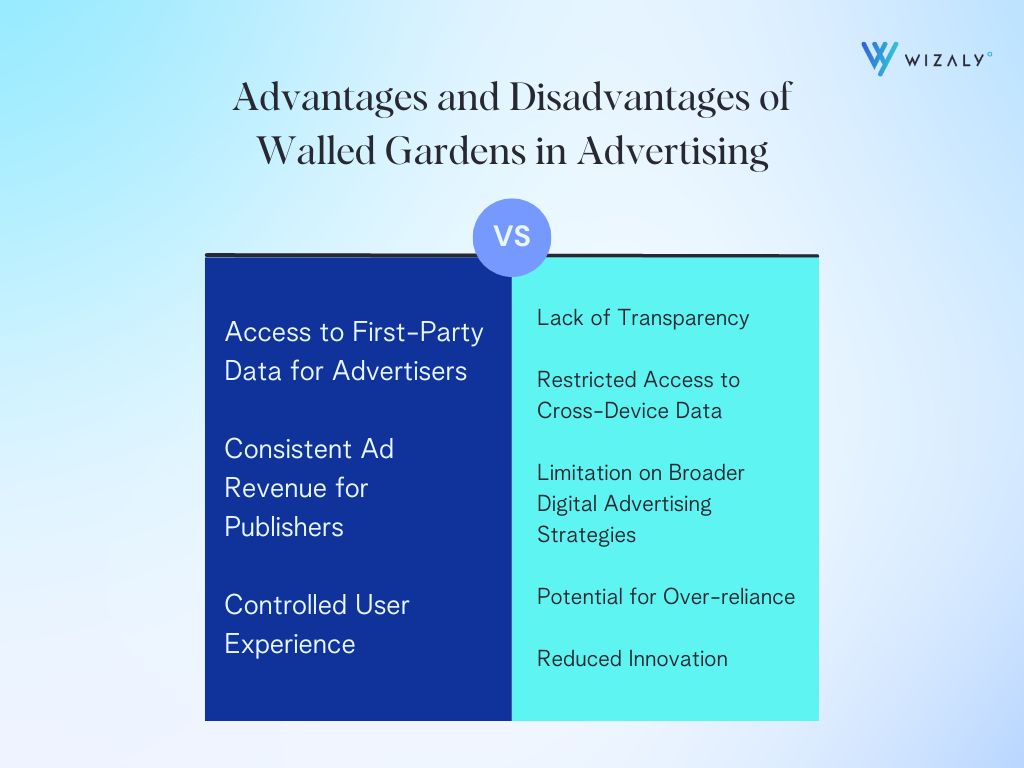The terms ‘walled garden’, ‘ad tech’, and ‘walled garden in advertising’ are becoming increasingly significant. With tech giants like Facebook and Amazon driving this concept, understanding its implications and applications in adtech is paramount for marketers and publishers alike. Dive into this article to grasp the essence of walled gardens, how they impact the advertising world, and what it means for your ad spend and campaigns. In the modern and constantly changing digital world, the phrases ‘enclosed space’, ‘technology for advertising’, and ‘enclosed space in advertising’ are growing in importance. With major technology companies such as Facebook and Amazon leading the way, it is crucial for marketers and publishers to comprehend the significance and uses of this concept in advertising technology. Explore this article to understand the core of enclosed spaces, their influence on the advertising industry, and the implications for your advertising expenses and campaigns.
What is a Walled Garden in the World of Adtech?
A ‘walled garden’ in adtech refers to a closed platform or ecosystem where the technology provider has significant control over the content, user data, and advertising options. Within this environment, the publisher provides content and services to users, but retains significant control over user data and the advertising options available to advertisers. This model is seen in walled gardens like Google and Facebook, where these tech giants have created their own closed ecosystems.
The History of Walled Gardens: Where Did it Begin?
The term “walled gardens” was first coined in the telecommunication industry, referring to the practices of tech companies like the Bell System, later acquired by AT&T. John Malone and others in the telecom space used it as a strategy to retain users and monetize their services efficiently. However, the term “walled gardens” has since been adopted by the tech industry as a whole, to describe a closed ecosystem where a company tightly controls access to content, applications, and services within its platform. This strategy aims to create a seamless user experience within the platform, while also locking users into the company’s own products and services. Walled gardens have become increasingly common in various tech sectors, including social media, e-commerce, and mobile operating systems.
Walled gardens can be beneficial for companies as they create a captive audience and enable tighter control over the user experience. They also provide opportunities for monetization through advertising, app sales, or subscription services. However, critics argue that walled gardens can stifle competition, limit user choice, and potentially lead to monopolistic practices.
How Do Walled Gardens Impact Publishers and Advertisers?
For publishers, walled gardens can be a double-edged sword. While they provide a streamlined ad manager system and potentially higher ad revenue, they also restrict access to valuable user data. Advertisers, on the other hand, may find it challenging to get an aggregated view of their campaigns across different platforms, which can impact ROI calculations. In addition, walled gardens can limit the control and flexibility that publishers and advertisers have over their ad placements and targeting options. They may have to rely on the platform’s predefined options and algorithms, which may not align with their specific advertising goals.
Moreover, walled gardens can create a sense of dependency on the platform, as publishers and advertisers may become heavily reliant on the platform’s ad manager system and tools. This can lead to a lack of diversification in their advertising strategies and a susceptibility to any changes or restrictions imposed by the platform.
Walled gardens also present challenges regarding transparency and accountability. Since the platform controls the data and metrics, publishers and advertisers may have limited visibility into how their ads are performing. This can make it difficult to gauge the effectiveness of their campaigns and make informed decisions for optimization.
Why are Big Tech Companies Like Google and Facebook Adopting this Approach?

Tech giants such as Google and Facebook see the walled garden approach as a way to maintain control over user data, ensure ad revenue, and enhance user experience by providing relevant content. By keeping data within their walls, they can offer advertisers unique insights, albeit in a restricted manner.
Walled Gardens and Header Bidding: What’s the Connection?
Header bidding is a programmatic advertising process where publishers offer ad space to multiple advertisers simultaneously before making calls to their ad servers. However, within the walled gardens of major platforms like Facebook, header bidding can be a challenge due to the closed nature of their ecosystems. In the case of major platforms like Facebook, header bidding can be challenging because these platforms have closed ecosystems. This means that publishers are limited to using Facebook’s ad server and can only access advertising demand from within Facebook’s network.
Header bidding relies on a publisher being able to connect to multiple demand sources simultaneously, allowing advertisers to compete for ad space. However, within the closed ecosystem of platforms like Facebook, publishers are restricted to using Facebook’s own auctions and cannot access other demand sources.
This closed nature of the ecosystem can limit the competition for ad space and potentially lead to lower ad revenues for publishers. It also limits the transparency and control that publishers have over their advertising inventory.
To work around this challenge, publishers on major platforms like Facebook typically rely on the ad server provided by the platform itself. They may also use other strategies like waterfalling, where they prioritize different demand sources sequentially to maximize their ad revenues within the platform’s constraints.
Overall, while header bidding has revolutionized programmatic advertising by increasing competition and transparency, it faces challenges within the closed ecosystems of major platforms like Facebook.
The Pros and Cons: Advantages and Disadvantages of Walled Gardens in Advertising

Pros (Advantages):
- Access to First-Party Data for Advertisers: Walled gardens provide advertisers with a treasure trove of first-party data. This data can be incredibly valuable for crafting highly targeted and personalized campaigns.
- Consistent Ad Revenue for Publishers: For publishers operating within a walled garden, the controlled environment can lead to steady and consistent ad revenue, ensuring a predictable income stream.
- Controlled User Experience: These closed ecosystems often offer users a more uniform and controlled browsing or user experience, which can be beneficial for brand consistency.
Cons (Disadvantages):
- Lack of Transparency: One of the main challenges of walled gardens is the limited visibility into user behaviors and other analytics. This lack of transparency can hinder marketers and publishers from gaining full insights into campaign performances.
- Restricted Access to Cross-Device Data: Walled gardens often limit access to cross-device user data, making it challenging for advertisers to get a holistic view of user behaviors across multiple devices.
- Limitation on Broader Digital Advertising Strategies: With restricted data and limited transparency, advertisers might find it challenging to integrate their strategies within walled gardens into broader digital marketing initiatives.
- Potential for Over-reliance: Relying too heavily on a single walled garden might result in missed opportunities on other platforms or in the open web.
- Reduced Innovation: In some cases, the controlled nature of walled gardens can stifle innovation, as publishers and advertisers have to adhere to the platform’s set parameters.
The Concept of Closed Ecosystems in Digital Advertising
Closed ecosystems, often called walled gardens, are where the tech platform has significant control over the hardware, software, and data. These environments offer a controlled user experience but can limit innovation and competition in the long run. In a closed ecosystem, the tech platform exercises control over various aspects, including the hardware, software, and data. This control allows them to create a controlled and consistent user experience. Examples of closed ecosystems include mobile operating systems like Apple’s iOS or proprietary gaming consoles like PlayStation.
Is Amazon’s Ad Strategy an Example of a Walled Garden Approach?
Absolutely. Amazon Ads operates within a closed environment, providing advertisers with access to its vast trove of user data, but under its terms and conditions. This walled garden approach enables Amazon to control the advertising narrative within its platform. As a result, advertisers can target their ads to specific Amazon users based on their shopping and browsing behavior, demographics, and interests. Amazon Ads offers a range of targeting options, including keyword targeting, product targeting, and audience targeting.
Moreover, Amazon Ads provides a highly measurable and cost-effective advertising solution. Advertisers can track performance metrics such as impressions, clicks, and conversions, allowing them to optimize their campaigns and maximize their return on investment.
Additionally, Amazon Ads benefits from the massive reach of the Amazon platform, which attracts millions of users worldwide. This vast user base, coupled with Amazon’s deep knowledge of customer behavior, presents a lucrative opportunity for advertisers to reach their target audience at the right moment in their shopping journey.
In conclusion, Amazon Ads offers advertisers a closed and controlled advertising environment, coupled with access to valuable user data and a vast user base. This combination makes it an attractive platform for advertisers looking to maximize the effectiveness and efficiency of their advertising campaigns.
How User Data and ROI are Affected Within Walled Garden Environments
Advertisers working within walled gardens often face challenges in accessing granular user data, which can affect campaign targeting and measurement. This limitation can impact the ROI of campaigns as advertisers might not get a holistic view of their ad spend’s effectiveness. Closed ecosystems or walled gardens refer to technology platforms, such as operating systems or app stores, that exercise tight control over various aspects including hardware, software, and data. In these environments, the platform owner has the authority to dictate what devices can run on their platform, what software can be installed, and what data can be accessed.
The primary advantage of closed ecosystems is that they provide a controlled and seamless user experience. Since the platform owner has control over all components, they can ensure compatibility, security, and a consistent user interface. This tightly integrated approach can enhance user satisfaction and simplify the overall experience.
However, closed ecosystems can also stifle innovation and hinder competition. The platform owner’s control can create barriers for developers and limit the variety of available software and services. This can lead to a lack of diversity, higher prices, and potentially lower quality options for consumers. Additionally, since the platform owner controls the data, it can also raise concerns regarding privacy and access to information.
As a consequence, closed ecosystems often face criticism for their potential to limit consumer choice, restrict market competition, and impede technological advancement. Open ecosystems, on the other hand, promote greater interoperability and competition as they allow multiple vendors and developers to contribute to the ecosystem without extensive control from a single entity.
Looking Forward: The Future of Walled Gardens in the Digital Marketing Landscape
As digital advertising evolves, the dynamics between walled gardens, publishers, and advertisers will continue to shift. While walled gardens offer a controlled environment, the demand for transparency and interoperability will shape their future role in digital marketing. Walled gardens refer to closed ecosystems operated by large technology companies like Google, Facebook, and Amazon, where they control access to their user data and advertising inventory. These platforms offer advantages such as vast audience reach, sophisticated targeting capabilities, and comprehensive measurement tools. However, they also limit data portability and insights outside of their environment, leading to concerns about transparency and control.
Publishers, on the other hand, create and distribute content, attracting audiences that advertisers want to reach. They rely on advertising revenue to support their operations and typically work with various ad tech vendors and platforms to monetize their inventory. However, publishers often struggle with competing for ad dollars and maintaining control over their data and user relationships.
Advertisers seek to connect with their target audiences effectively. They want access to quality inventory, precise targeting, and transparent measurement to assess the impact of their campaigns. However, they also desire greater control over their ad placements, data ownership, and the ability to navigate between different platforms seamlessly.
As digital advertising evolves, there is a growing demand for transparency and interoperability between walled gardens, publishers, and advertisers. Advertisers are increasingly pushing for access to data and performance insights across various platforms to evaluate their campaigns’ effectiveness holistically. They desire the ability to compare results and optimize their strategies without being limited to a single ecosystem.
Publishers, too, want more control over their data and user relationships. They are exploring partnerships and solutions that allow them to retain ownership of their audience insights while leveraging walled garden technologies. Publishers also seek ways to maintain direct relationships with advertisers and reduce reliance on third-party intermediaries.
While walled gardens offer a controlled environment and unmatched targeting capabilities, their future role in digital marketing is likely to be shaped by the demand for transparency and interoperability. Platforms are gradually opening up, allowing data sharing and integration with external systems. Advertisers and publishers are also exploring alternative solutions, such as independent third-party measurement tools and identity solutions, to reduce their dependence on walled gardens.

Key Takeaways:
- A walled garden in advertising is a closed ecosystem where tech giants control user data and ad options.
- Originated in the telecommunication industry, it’s now dominant in digital marketing.
- Publishers face challenges in accessing granular data within walled gardens.
- Advertisers benefit from vast first-party data but with restricted insights.
- The future of digital advertising will see a tug-of-war between walled gardens’ control and the demand for transparency.
Unlock the Power Beyond Walled Gardens with Wizaly!
Don’t let the constraints of walled gardens limit your marketing potential. Dive deeper with Wizaly and equip your team with the analytics and insights they deserve. Discover how Wizaly can be your key to bypassing barriers, accessing crucial data, and driving smarter, data-driven decisions. 🔓📊
Explore Wizaly’s Solutions Today and Elevate Your Marketing Strategy!



